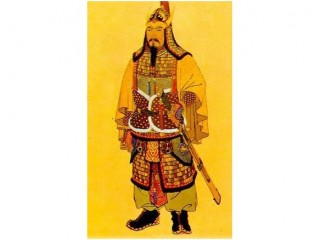
Gwanggaeto The Great biography
Date of birth : -
Date of death : -
Birthplace : Korea
Nationality : Korean
Category : Historian personalities
Last modified : 2011-10-12
Credited as : Korean king, Liaotung Peninsula, Yalu River
Kwanggaet'o (375-413) was the nineteenth ruler of Koguryó, an ancient northern Korean kingdom. A brave warrior and a great national leader, he was
known chiefly for his successful conquest and expansion of Koguryó territory.
Son of King Kogugyang (reigned 384-391), Kwanggaet'o was known during his life as Great King Yóngnak, which was also his reign title and the first era name adopted by a Korean king. He took by storm (392, 395) the settlements of Piryó, recently identified with the Khitan, along the Liao River; to the west, he repulsed the invasions of the Later Yen, established by the Mu-jung tribes of the Hsien-pi, and occupied the Liaotung Peninsula (400, 405, 406). To the northeast, he subjugated the Sukchin people (398); and to the north, he attacked East Puyó, extending Koguryó's northern border (410).
Kwanggaet'o's southward expansion was equally successful. With the fall of the Chinese commanderies Lolang and Tai-fang, Koguryó and the southern kingdom of Paekche came face to face for the first time and contended for territorial acquisition. In 391 the King stormed 10 walled towns of Paekche; in 393 and 394 he repulsed Paekche's attempted northward push; and in 396, personally leading large naval forces, he crossed the Han River and laid siege to the Paekche capital, Hansóng, modern Kwangju. Paekche then sued for peace, and the King returned with the Paekche ruler's brother as hostage. During this campaign, Kwanggaet'o took 58 walled towns and 700 villages.
When Paekche attempted to check the Koguryó advance with military help from Japan, the King waged a single great war (407), and his 50,000 infantry and cavalry routed the enemy. In 399, at the request of Silla, which was suffering from Japanese encroachment along its borders, Kwanggaet'o's army annihilated the Japanese forces along the present Naktong River (400). When he pursued the remnants of fleeing Japanese to the state of Kara, a Japanese ally on the southern tip of the peninsula, the latter surrendered. In 404 he destroyed the Japanese fleet infiltrating the country's southwestern border.
History is relatively silent about the domestic administration of Kwanggaet'o, but without a solid social and economic structure, the country could not have supported these protracted massive war efforts. His stele, erected in 414 in Chi-an in the middle reaches of the Yalu River near the Korean border, was discovered only about 1880. It consists of 1,802 logographs and records Koguryó national tradition, together with the royal genealogy, the King's exploits, and a list of the royal mausoleum keepers entrusted with the task of preserving the King's grave nearby. The most important part of the inscription is that recording chronologically the King's martial prowess and heroic valor, befitting his title, "Expander of the Realm."
The reign of Kwanggaet'o is treated in Han Woo-keun, The History of Korea (1970). □
















